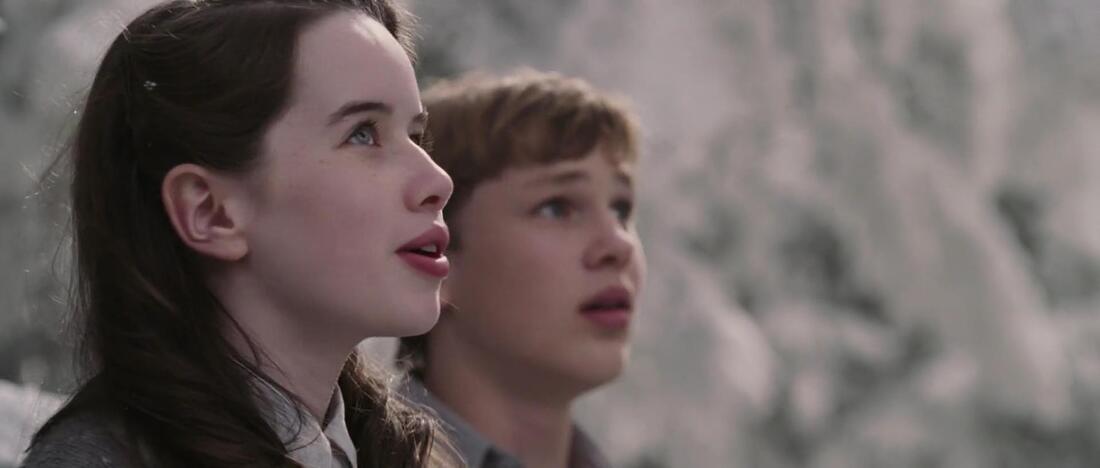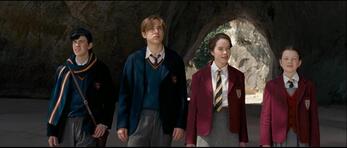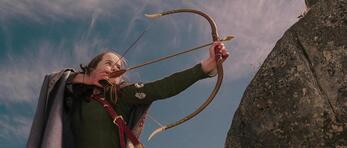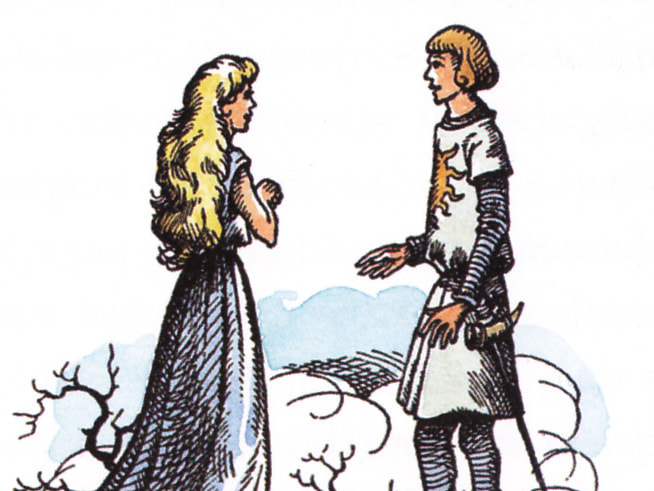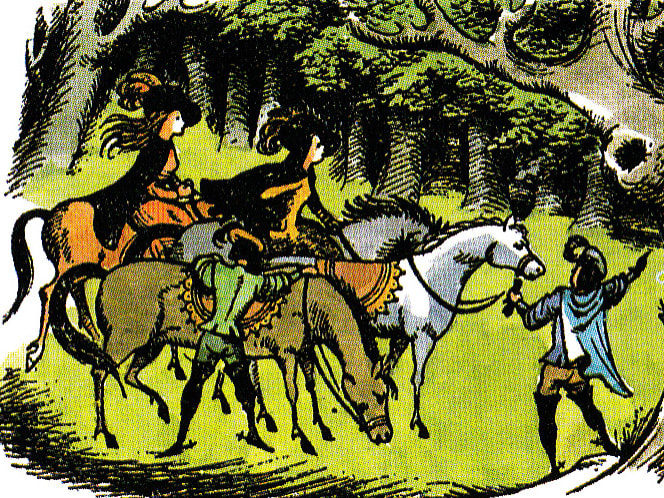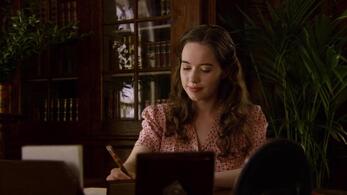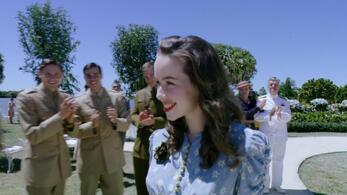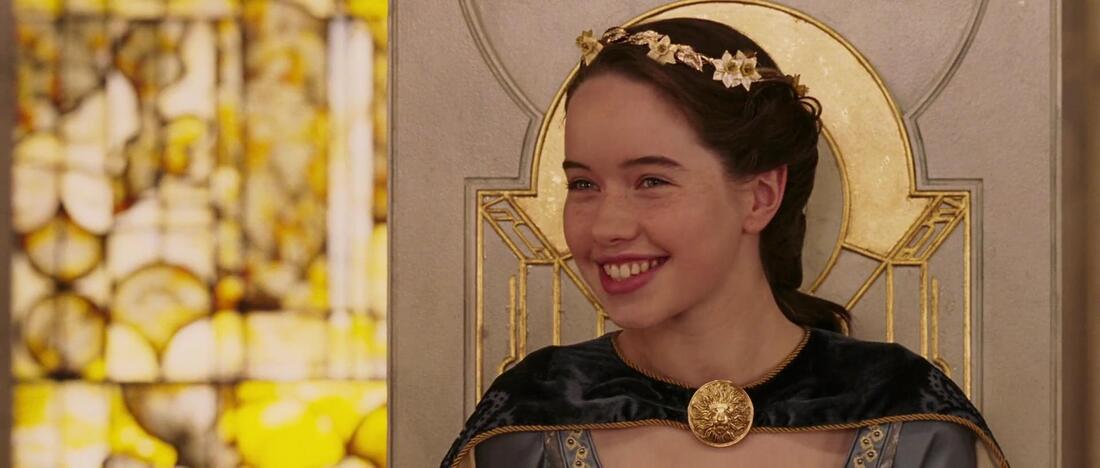|
Do you remember opening up The Lion, the Witch and the Wardrobe for the first time, or better yet having one of your parents open the book up so that you could go to Narnia together? Do you remember what it felt like to visit that magical land of talking beavers and fauns, heroes and villains, mysterious forests and shining castles? It almost seems like a real place. There’s just something about the story that keeps drawing readers in. Kids today still fall in love with Narnia, stumbling through the wardrobe with Lucy and her siblings, Peter, Susan, and Edmund. The four Pevensie children have an unforgettable adventure there and are crowned kings and queens at the end of the story by the great lion Aslan himself. But that’s only the first novel in The Chronicles of Narnia series. Other stories follow, characters come and go, and some characters change in surprising ways. Lucy’s sister Susan is someone who takes a turn later in life. At the end of the series, when the battle is won and the now grown-up Pevensies and all our favourite characters return to live with Aslan in the new and restored Narnia, Susan isn’t there. Why? Because she doesn’t believe in Narnia anymore. As Peter tells us, Susan is “no longer a friend of Narnia.” We learn that she has turned her back on the fantastical land she visited as a child and seems to have convinced herself that Narnia was just a place she and her siblings made up. It was a story only children could believe in. How is that possible? Susan actually goes to the land of Narnia and sees it transfigured from endless winter to a brilliant spring. She witnesses the defeat of the White Witch and of the tyrant usurper Miraz. And Susan is there in the moments before Aslan's death. She and Lucy walk with Aslan on his sad march towards the Stone Table. They bury their fingers in his shaggy mane. When Aslan asks what the two of them are doing there, Susan replies, "Please, may we come with you—wherever you're going?" How could Susan, after all that, forget about Narnia? Well, having never travelled to a land of talking animals myself and reigned there for years and years as a benevolent monarch, I can’t comment on the likelihood that I would be able to totally discount such an experience as pure imagination after the fact. All I can say is that it must take a great deal of effort to deny reality, because reality has the annoying habit of never really going away, even if we do our very best to ignore it. But laying that issue aside for the moment, it will be more fruitful to look at how Susan lives her life now that she has thrown off her belief in Narnia as a real place. Some literary critics seem to admire Susan for laying her childhood to rest. After all she has more important things with which to occupy her time. She’s an adult now, a woman who dresses up for parties and going out on the town. She has a liking for “nylons and lipstick and invitations.” We can’t all be Peter Pan trapped in Neverland. Some of us have to grow up. It seems that Susan has simply moved on. Her world has expanded and she’s finding her place in it. We shouldn’t be surprised that Susan, like every young person her age, is discovering what it means to be an adult. Some critics allege that author C.S. Lewis disapproved of children maturing into young men and women and pursuing romantic interests. Some charge him with sexism. Novelist Philip Pullman, author of the His Dark Materials trilogy, claims that Lewis “didn’t like women in general, or sexuality at all.” But is all that true? In the third Narnia novel The Voyage of the Dawn Treader Lewis doesn’t seem to have any problem with the now grown-up King Caspian and Ramandu’s daughter falling in love and getting married. When Caspian meets her, he and all the rest of his companions recognize her as “a great lady.” Even when Caspian’s boyish, independent spirit gets the better of him and he gets the bright idea of sailing alone into the great unknown and to the very edge of the world, Lewis doesn’t let him. He brings in the character of Aslan to set him straight. Caspian realizes that he can’t act like a child without responsibility. He’s a grown up with a duty to his royal subjects, and his lovely lady to think about. And let’s not forget that all four of the Pevensie children, including Susan, grow up. In fact they get to do it twice—once in Narnia and once in our world. In The Lion, the Witch and the Wardrobe they live for years in what is known as Narnia’s Golden Age. We learn that “Susan grew into a tall and gracious woman with black hair that fell almost to her feet and the Kings of the countries beyond the sea began to send ambassadors asking for her hand in marriage.” Of course, these potential relationships wouldn’t have worked out in the end, perhaps for obvious reasons. Having a husband who lives in another world takes long-distance relationships to a whole new level. So if it’s not the fact of Susan growing up that seems to bother Lewis, what is? Could it be that critics like Pullman have missed something important? The problem is not that Susan has moved on. The problem is that she can’t move on. Let’s look at her current situation a bit more closely. Susan appears grown up, but she actually has a lot more growing up to do than she knows. One character tells us that Susan “wasted all her school time wanting to be the age she is now, and she'll waste all the rest of her life trying to stay that age.” Definitely a sweeping statement, but it gives us insight into Susan’s mindset. Society has finally recognized her as an adult. She thinks she’s arrived. But in reality Susan has a whole life ahead of her. My previous article was about the novel Bridge to Terabithia and the seasons of life. I wrote how each stage in your life has value and that each is a bridge to the next stage. It’s true that there comes a time when we need to move on. But that doesn’t mean we forget our past—the people and the experiences that brought us here. We don’t have to discount them. In fact it can be quite a humbling exercise to look back and think about how your past experiences have helped shape you, rather than imagining that you suddenly appeared one day as the person you are now. Susan has reached the season in life she’s been looking forward to, but the problem is that she wants to stay there forever. There’s more to life than she knows, more to come in her story than she can dream up. But she just can’t see it yet. Instead she has set aside both the past and the future, turning her attention to trying to control her present. Her world has ground to a halt, frozen in time just as the land of Narnia is when the Pevensies first enter in through the wardrobe. It is a place where it’s always winter, never Christmas—at least until Aslan breaks the spell. Is Susan’s story over then? We don’t hear what happens to her next. Does she stay trapped like some of us are, too old to listen to fairy tales and yet too young to see their deeper value? Author C.S. Lewis didn’t think so. He wrote a letter to a reader on this very question, telling us that there is hope for Susan yet. He wrote that “there is plenty of time for her to mend, and perhaps she will get to Aslan's country in the end—in her own way.” If it’s been a few years since you read The Lion, the Witch and the Wardrobe, you may have forgotten about the dedication at the front of the book. Author C.S. Lewis dedicated the novel to his young goddaughter Lucy Barfield. Inspiration for writing the story came to Lewis during World War II, but by the time it was published the war was five years past. Lucy was thirteen-years-old when she received the manuscript. In his dedication Lewis writes, My Dear Lucy, Some day we will be old enough to go back to the stories of our youth and not feel embarrassed. We won’t feel that we’re too good them, or that we’ve outgrown them. There’s something Lewis knew that some other adults do not—that the best stories, including so-called children’s stories, never lose their value. No matter how old we are. Lewis’s goddaughter Lucy Barfield attended a theatre performance of The Lion, the Witch and the Wardrobe in London in her late 40s. She was the guest of honour. And later near the end of her life, as she was suffering from multiple sclerosis, she said, “What I could not do for myself the dedication did for me. My Godfather gave me a greater gift than I had imagined.” Narnia is not like Neverland where our heroes never grow up. During the Pevensies’ second visit to Narnia in the novel Prince Caspian, Lucy meets Aslan and is surprised how large he looks. But he corrects her. It’s not that Aslan has grown—Lucy has. He tells her, “every year you grow, you will find me bigger.” Every year she matures and her knowledge and experience grow, Lucy realizes that there’s more to Aslan than she thought.
Susan isn’t the first Pevensie to deny the existence of Narnia. Edmund did it first and, what was worse, he betrayed his siblings into the hands of the White Witch in the process. If Edmund could come back from that, so could Susan. I think we get a clue to Susan’s fate near the end of The Lion, the Witch and the Wardrobe. Aslan says, “Once a king or queen in Narnia, always a king or queen in Narnia.” I believe Queen Susan will grow up in the end. And when she does she’ll realize that the truths she learned as a child are still true today.
Comments
|
David Raphael HilderJoin the conversation as we explore the best there is in fantasy, sci-fi, adventure, and of course, the classics Archives
December 2020
Categories
All
|

